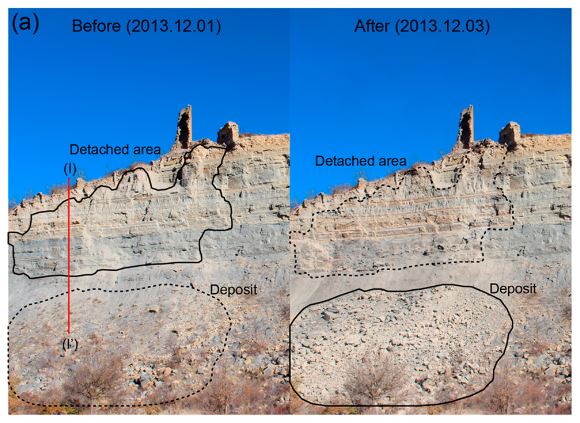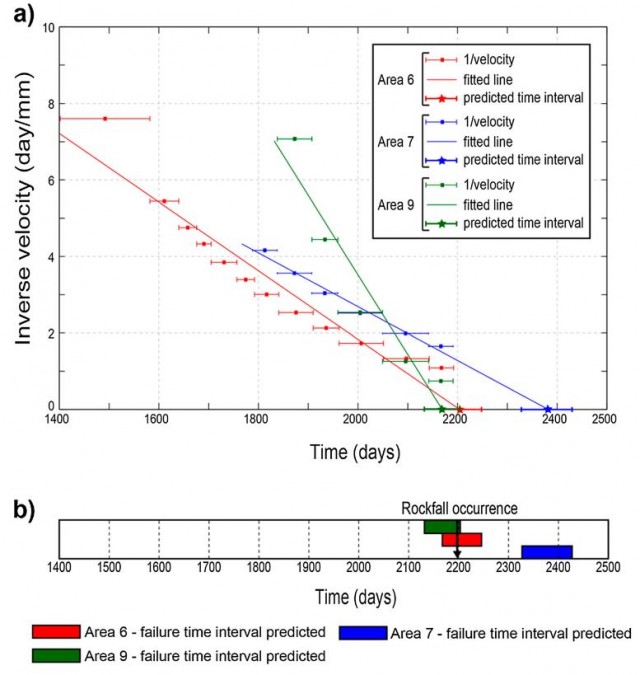13 April 2015
Review of a paper: progressive failure leading to a rockfall in Catalonia, Spain
Posted by Dave Petley
Progressive failure leading to the 3 December 2013 rockfall at Puigcercós scarp (Catalonia, Spain)
Progressive failure – the idea that landslides progress to failure over a period of time – has been a topic of considerable discussion for the last 50 years, and has been a focus of considerable attention for the last decade or so. As well as being fundamental to our understand of landslide mechanics, being able to identify patterns of movement prior to collapse potentially provides the basis for early warning systems, which can (in principle at least) be used to protect vulnerable populations. Probably the most important observation in this respect is that of the so-called Saito Effect, which is that some (but certainly not all) landslides display a hyperbolic increase in velocity through time in the period leading up to failure. This is an interesting and useful observation, because plotting the inverse of velocity (i.e. 1/v) against time yield a straight line, which allows the time of failure to be correctly predicted (failure occurs when 1/v = 0). Of course the devil is in the detail, and correctly identifying when the linear trend has started is challenging in a noisy dataset. In addition, the Saito effect only works for some landslides (they have to be controlled by brittle mechanisms for example), and even then it appears that it can be a little hit or miss.
So, it is important to investigate further the mechanisms of slope failure. This has been greatly helped by technological developments. For example, monitoring equipment is now cheaper, more reliable and more capable. Even low cost dataloggers can collect very high temporal resolution data, and of course with mobile phone systems it is often possible to send the data back to base in real time. The upshot has been an increase in papers that examine high resolution monitoring data to explore progressive failure. Writing in the journal Landslides, Royan et al. (2015) have examined the pre-failure behaviour of a rockfall at the Puigcercós study site in Catalonia, Spain. This is a near vertical rockslope that suffered a comparatively large (1000 cubic metre) rockfall event on 2nd / 3rd December 2013. The team had been monitoring the slope using terrestrial LiDAR for six years prior to the collapse event.
.
The resolution of the terrastrial LiDAR is such that the movement of the rockfall prior to collapse could be calculated from successive scans, and from this the velocity could be determined, which in turn permits investigation of the nature of progressive failure at the site. This is in reality far from trivial, and required the developed development of new approaches by the project team. They divided the rock face into a series of zones and then looked at the velocity in each of them. In three of the zones, the Saito effect was clearly observed:-
.
The arrow in figure (b) indicates the time of the large failure event. The best fit line for areas 6 and 9 correctly predicts this time of failure remarkably well, with the linear trend developing more than a year before the collapse. The linear trend for area 7 predicts a later failure event – the authors hypothesize that this was developing into a separate failure, but that the major collapse precipitated the collapse of this section as well. Interestingly, the project team also saw an increase in the number and rate of rockfall events in these areas prior to the major rockfall. I would think that this is a sign of an increasing rate of deformation of the rock mass as failure developed, which is also an indication of progressive failure.
Finally, the project team looked at the major rockfall event in relation to potential trigger events, such as heavy rainfall. In their words:
“No clear external triggering factor was detected for this event. Therefore, the evolution over time of the precursory indicators suggests that just stability reasons seem to be the most probable cause of the final failure. The continuous increase in deformation of areas 6 and 9 created a critical situation in terms of stability, and these areas eventually fell without any external trigger. This approach is supported by the hypothesis exposed in Rosser et al. (2007) in which when the instability is in the tertiary creep phase, the environmental forces have little or no discernible influence in the evolution of the instability and therefore in the final failure.”
I think that this is an extremely interesting and important paper that makes a substantial contribution to our understanding of the development of progressive failure. That once again failure is seen to be a long term process rather than a one-off response to a single trigger is fascinating, and paves the way for improved early warning systems.
References
Royán, M.J., Abellán, A. and Vilaplana, J.M. 2015. Progressive failure leading to the 3 December 2013 rockfall at Puigcercós scarp (Catalonia, Spain). Landslides. http://dx.doi.org/10.1007/s10346-015-0573-6
Rosser, N.J., Lim, M., Petley, D.N., Dunning S. and Allison R.J. (2007) Patterns of precursory rockfall prior to slope failure. J Geophys Res 112, F04014. http://dx.doi.org/10.1029/2006JF000642




 Dave Petley is the Vice-Chancellor of the University of Hull in the United Kingdom. His blog provides commentary and analysis of landslide events occurring worldwide, including the landslides themselves, latest research, and conferences and meetings.
Dave Petley is the Vice-Chancellor of the University of Hull in the United Kingdom. His blog provides commentary and analysis of landslide events occurring worldwide, including the landslides themselves, latest research, and conferences and meetings.